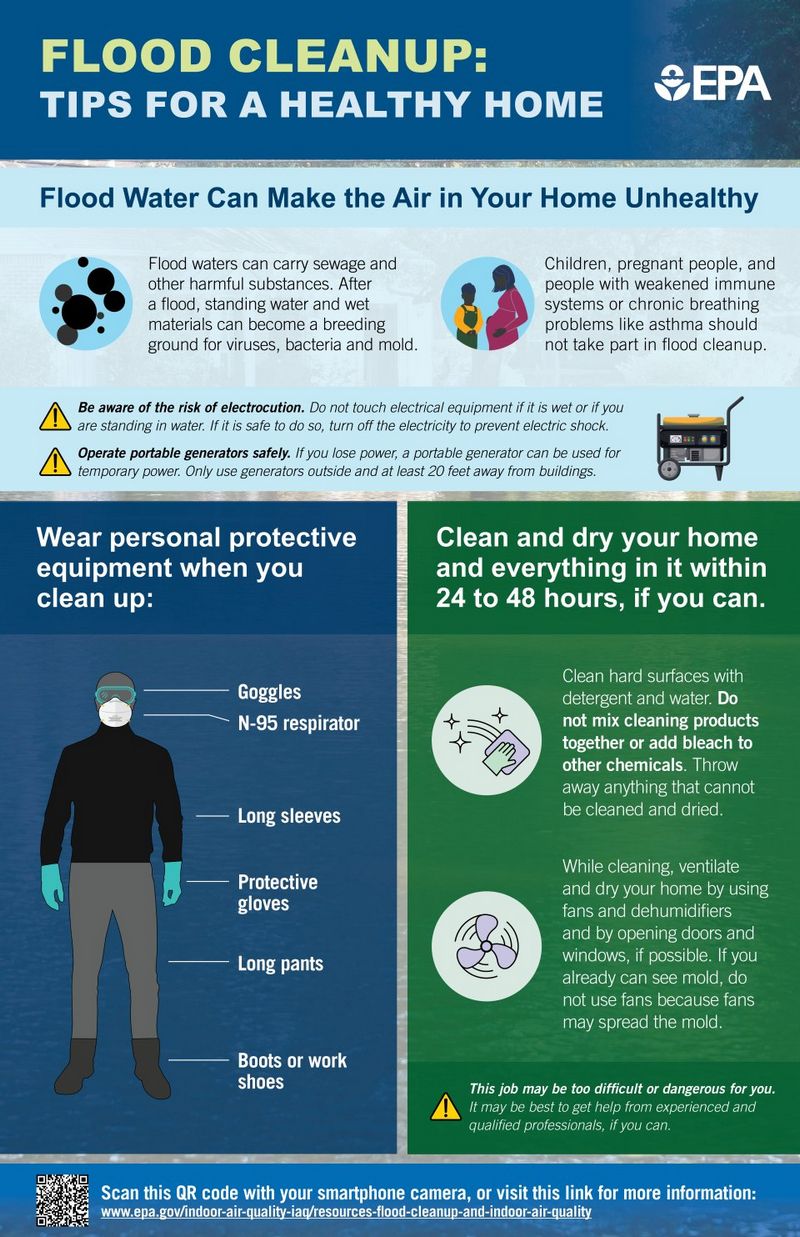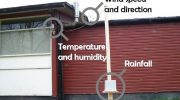
Simple Methods to Enhance the Quality of Indoor Air in Your Home: 4 Helpful Tips
Indoor air quality (IAQ) is an important aspect of our overall health and well-being, yet it is often overlooked. However, with a few simple tips, you can significantly improve the air quality in your home and create a healthier living environment for you and your family.
Tip 1: Keep your home clean and dust-free
Cleaning your home regularly is crucial for maintaining good indoor air quality. Dust particles and allergens can accumulate on surfaces and in the air, leading to respiratory issues and allergies. Make sure to vacuum carpets and rugs, mop floors, and dust surfaces frequently. Using a high-quality air purifier can also help remove particles from the air.
Tip 2: Control humidity levels
Excessive humidity in your home can promote the growth of mold and mildew, which can have a negative impact on your indoor air quality. Use a dehumidifier to control the humidity levels in your home, especially in areas prone to moisture, such as bathrooms and basements. Additionally, ensure proper ventilation by opening windows and using exhaust fans.
Tip 3: Avoid indoor pollutants
There are many indoor pollutants that can negatively affect your IAQ. Avoid smoking inside your home, as tobacco smoke contains harmful chemicals that can linger in the air for a long time. Additionally, be mindful of using harsh cleaning products, as they can release volatile organic compounds (VOCs) into the air. Opt for natural alternatives whenever possible.
Tip 4: Increase ventilation
Proper ventilation is essential for maintaining good IAQ. Make sure your home is well-ventilated by opening windows and using exhaust fans when cooking or showering. You can also invest in an air purifier with a built-in ventilation system to constantly refresh the air in your home and remove harmful pollutants.
By following these tips, you can significantly improve the indoor air quality in your home, creating a healthier and more comfortable living environment for you and your family.
Importance of Indoor Air Quality (IAQ)
Indoor air quality (IAQ) is the quality of air within buildings and structures, especially as it relates to the health and comfort of occupants. With the majority of people spending a significant amount of time indoors, whether at home or in the office, it is crucial to improve and maintain good IAQ.
Poor indoor air quality can have a negative impact on our health. The air inside our homes can contain pollutants such as dust, mold, pet dander, and chemicals from cleaning products. Breathing in these pollutants can cause irritation of the eyes, nose, and throat, as well as respiratory issues, allergies, and asthma.
Improving IAQ in our homes is essential for creating a healthy living environment. Here are four tips to help improve indoor air quality:
- Regularly clean and vacuum: Dust and dirt can accumulate in carpets, upholstery, and other surfaces. Regularly cleaning and vacuuming these areas can help reduce the amount of dust and allergens in the air.
- Control moisture: High humidity levels can contribute to the growth of mold and mildew, which can negatively impact IAQ. Using dehumidifiers and properly ventilating areas of high moisture, such as bathrooms and kitchens, can help control humidity levels.
- Avoid smoking indoors: Cigarette smoke contains numerous harmful chemicals and pollutants that can linger in the air for long periods. Creating a smoke-free environment indoors can greatly improve IAQ.
- Use air purifiers: Air purifiers can help remove airborne particles and pollutants from the air. They can be particularly beneficial for individuals with allergies or asthma.
By implementing these tips, you can significantly improve the indoor air quality in your home. Breathing clean and fresh air can lead to better overall health and well-being for you and your family.
Common Indoor Air Pollutants
When it comes to improving indoor air quality (IAQ), it’s important to understand the common pollutants that can be found in our homes. By identifying and addressing these pollutants, we can greatly improve the air we breathe and create a healthier living environment.
1. Dust and Allergens: Dust, pet dander, pollen, and other allergens can accumulate in our homes and lead to respiratory issues, allergies, and asthma. Regular dusting and vacuuming can help reduce the presence of these particles in the air.
2. Volatile Organic Compounds (VOCs): VOCs are chemicals that can be found in many common household products such as paints, cleaning supplies, and furniture. These chemicals can off-gas and contribute to poor air quality. Using low-VOC or no-VOC products can help minimize exposure to these harmful substances.
3. Mold and Mildew: Excess moisture in our homes can lead to the growth of mold and mildew. These fungi can release spores into the air, which can cause respiratory issues and allergies. It’s important to address any moisture issues and promptly address any mold or mildew growth.
4. Tobacco Smoke: Secondhand smoke from tobacco products can greatly affect indoor air quality. It contains numerous chemicals and carcinogens that can lead to a wide range of health issues, including respiratory problems, lung cancer, and heart disease. It’s best to avoid smoking indoors and create a smoke-free environment.
5. Radon: Radon is a naturally occurring radioactive gas that can seep into our homes from the ground. Prolonged exposure to high levels of radon can increase the risk of developing lung cancer. Testing for radon and addressing any high levels is crucial for maintaining a healthy indoor environment.
6. Carbon Monoxide: Carbon monoxide is a colorless and odorless gas that can be produced by sources like gas appliances, fireplaces, and generators. Breathing in high levels of carbon monoxide can lead to symptoms like headaches, dizziness, and even death. Regularly maintaining and inspecting these sources can help prevent carbon monoxide leaks.
7. Pet Hair and Dander: If you have pets, their hair and dander can contribute to poor indoor air quality. Regular grooming, vacuuming, and keeping pets out of bedrooms can help minimize the impact of pet allergens on our respiratory health.
8. Particulate Matter: Particulate matter refers to tiny particles suspended in the air, such as dust, soot, and pollen. These particles can be inhaled and lead to respiratory issues, especially for those with pre-existing conditions like asthma. Using air purifiers and regularly changing air filters can help reduce the amount of particulate matter in the air.
- Dust and Allergens
- Volatile Organic Compounds (VOCs)
- Mold and Mildew
- Tobacco Smoke
- Radon
- Carbon Monoxide
- Pet Hair and Dander
- Particulate Matter
By being aware of these common indoor air pollutants and taking steps to minimize their presence, we can significantly improve the indoor air quality in our homes and promote a healthier living environment for ourselves and our families.
Health Effects of Poor IAQ
Indoor air quality (IAQ) plays a crucial role in the overall health and well-being of individuals. Poor IAQ can have significant health effects on occupants, ranging from mild discomfort to serious respiratory issues. It is essential to improve IAQ in your home to ensure a healthy living environment.
1. Respiratory Problems:
Poor IAQ can lead to various respiratory problems, especially among individuals with pre-existing conditions such as asthma or allergies. Contaminants, such as dust, pollen, pet dander, and mold spores, can exacerbate symptoms and cause breathing difficulties. It can trigger coughing, wheezing, shortness of breath, and even asthma attacks.
2. Allergic Reactions:
Exposure to indoor allergens, such as dust mites, cockroach droppings, and mold, can cause allergic reactions in sensitive individuals. Common symptoms may include sneezing, runny or stuffy nose, itchy or watery eyes, and skin rashes. Long-term exposure to these allergens can lead to chronic allergic conditions.
3. Irritation and Discomfort:
Poor IAQ can cause irritation and discomfort to the occupants. Chemical pollutants like volatile organic compounds (VOCs) from cleaning products, paints, and furniture can cause eye, nose, and throat irritation. It can also lead to headaches, fatigue, and difficulty concentrating, affecting overall productivity and quality of life.
4. Respiratory Infections:
Poor IAQ can increase the risk of respiratory infections, including coughs, colds, and flu. Contaminants, such as viruses, bacteria, and fungi, can circulate in the indoor air and easily spread among the occupants. Close living quarters and low ventilation can contribute to the transmission of infectious diseases.
5. Long-Term Health Effects:
Long-term exposure to poor IAQ can have serious health consequences. Studies have shown that prolonged exposure to indoor air pollutants can increase the risk of developing respiratory diseases, cardiovascular problems, and even certain types of cancer. Children, the elderly, and individuals with compromised immune systems are particularly vulnerable to these health effects.
Improving IAQ in your home is crucial to maintain a healthy living environment. Regularly ventilating your home, using air purifiers, minimizing the use of harmful chemicals, and keeping the indoor space clean and free of moisture can significantly reduce the health risks associated with poor IAQ.
Tip #1: Proper Ventilation
Proper ventilation is essential for improving indoor air quality (IAQ) in your home. Good ventilation helps to remove stale and polluted air, bringing in fresh and clean air from the outdoors. It also helps to control the levels of moisture, odors, and contaminants in the air.
Here are some ways to ensure proper ventilation in your home:
- Open windows and doors: Opening windows and doors allows for natural airflow and helps to remove stagnant air. It also allows fresh air to enter your home, improving the quality of indoor air.
- Use exhaust fans: Install exhaust fans in areas prone to moisture, such as the bathroom and kitchen. These fans help to remove excess humidity and prevent the growth of mold and mildew.
- Clean air ducts: Regularly clean and maintain your air ducts to prevent the buildup of dust, allergens, and other pollutants. This helps to ensure that the air circulating in your home is clean and healthy.
- Invest in an air purifier: Consider investing in an air purifier with a HEPA filter. These purifiers can help to remove airborne pollutants, such as dust, pollen, pet dander, and mold spores, improving the overall indoor air quality.
By implementing these tips and ensuring proper ventilation in your home, you can significantly improve the quality of indoor air and create a healthier living environment for you and your family.
Tip #2: Regular Cleaning and Maintenance
One of the most effective ways to improve indoor air quality (IAQ) in your home is through regular cleaning and maintenance. Dust, dirt, and other pollutants can easily accumulate in your home, which can contribute to poor air quality. Here are some tips to help you keep your home clean and maintain a healthy indoor environment:
-
Vacuum and dust regularly: Regular vacuuming and dusting can help remove allergens, dust mites, and other particles that can impact IAQ. Be sure to vacuum carpets, rugs, and furniture using a vacuum cleaner with a HEPA filter, which can trap small particles more effectively.
-
Keep your floors clean: Dirty floors can be a major source of pollutants in your home. Sweeping, mopping, or using an automatic floor cleaner can help remove dirt, dust, and pet dander from hard surfaces.
-
Change your air filters regularly: Dirty air filters in your heating, ventilation, and air conditioning (HVAC) system can restrict airflow and reduce IAQ. Check the manufacturer’s instructions for the recommended filter replacement schedule, and be sure to change them as needed.
-
Keep your kitchen clean: Cooking can release pollutants such as grease, smoke, and odors into the air. Regularly clean your kitchen surfaces, range hood, and stove to prevent the buildup of these pollutants.
-
Manage humidity levels: Excessive humidity can contribute to the growth of mold and mildew, which can impact IAQ. Use dehumidifiers in areas with high moisture levels, and be sure to fix any leaks or water damage promptly.
By incorporating regular cleaning and maintenance into your routine, you can help ensure that your home has better indoor air quality. These simple tips can make a big difference in promoting a healthier and more comfortable living environment.
Tip #3: Use Air Purifiers
Using air purifiers is one of the most effective ways to improve indoor air quality (IAQ) in your home. These devices help remove harmful pollutants and allergens from the air, making it cleaner and healthier to breathe.
Air purifiers work by using filters to trap particles such as dust, pollen, pet dander, and even some bacteria and viruses. They also help eliminate odors and reduce the presence of volatile organic compounds (VOCs) in the air.
When choosing an air purifier, consider the size of the room where you plan to use it. Air purifiers are rated based on the size of the room they can effectively clean, so make sure to choose one that is appropriate for the space you have.
Additionally, look for air purifiers with HEPA filters, as these are highly efficient at filtering out small particles. Some models also come with activated carbon filters, which can help remove odors and chemicals. Consider getting an air purifier with a built-in air quality sensor, as this can automatically adjust the fan speed based on the air quality readings.
To get the most out of your air purifier, make sure to clean or replace the filters regularly. Follow the manufacturer’s instructions on how often to clean or replace the filters, as this can vary depending on the model.
Using air purifiers can greatly improve IAQ in your home, reducing the risk of respiratory problems and allergies. It is an investment in your health and well-being, providing cleaner and fresher air to breathe.
Tip #4: Reduce Indoor Humidity
Excessive indoor humidity can lead to a number of problems, including the growth of mold and mildew, the release of harmful pollutants, and discomfort for residents. To improve the indoor air quality (IAQ) in your home, it is important to reduce indoor humidity levels. Here are four tips to help you achieve this:

- Use exhaust fans: Install and use exhaust fans in your bathrooms and kitchen to remove moisture and humidity from these areas. Make sure the fans are vented to the outdoors, rather than just circulating the air within your home.
- Fix leaks and water damage: Inspect your home for any leaks or signs of water damage, such as wet spots, stains, or peeling paint. Repairing these issues will help prevent moisture buildup and reduce indoor humidity.
- Use dehumidifiers: Consider using dehumidifiers to reduce humidity levels in your home. These devices extract moisture from the air and can be particularly useful in basements, laundry rooms, and other areas prone to higher humidity.
- Proper ventilation: Ensure that your home has proper ventilation to allow fresh air to circulate and reduce humidity levels. Opening windows and using ceiling fans can help improve ventilation and reduce indoor humidity.
By following these tips, you can effectively reduce indoor humidity levels, improve air quality, and create a healthier living environment for you and your family.
Signs of Poor IAQ
Poor indoor air quality (IAQ) can have a negative impact on your health and overall well-being. It is important to be aware of the signs that indicate your home may have poor IAQ. By recognizing these signs, you can take steps to improve the air quality in your home and create a healthier living environment for you and your family.
1. Frequent Allergies and Respiratory Issues
If you or your family members experience frequent allergies, such as sneezing, coughing, or itchy eyes, it could be a sign of poor IAQ. Indoor air pollutants, such as dust mites, pet dander, pollen, and mold spores, can trigger allergic reactions and respiratory issues. These allergens can accumulate in your home and circulate in the air, making it difficult to breathe and causing discomfort.
2. Persistent Odors
If you notice persistent odors in your home that do not go away with regular cleaning, it could be a sign of poor IAQ. Indoor air pollutants, such as volatile organic compounds (VOCs), tobacco smoke, cooking odors, and household cleaning products, can release unpleasant smells that linger in the air. These odors can be a result of poor ventilation or the presence of harmful chemicals in the indoor air.
3. Excessive Dust and Dirt
If you find yourself constantly cleaning and dusting your home, but the dust and dirt keep coming back, it could indicate poor IAQ. Dust and dirt particles can accumulate in your home and settle on surfaces, furniture, and floors. Poor IAQ can contribute to the buildup of these particles, making your home dusty and dirty. Breathing in dust particles can also worsen allergies and respiratory issues.
4. Mold and Mildew Growth
Mold and mildew thrive in damp and humid conditions, which can be a result of poor IAQ. If you notice mold or mildew growth in your home, especially in areas with high moisture, such as bathrooms or basements, it is a sign of poor IAQ. Mold spores can become airborne and circulate in your home, causing allergic reactions and respiratory issues.
If you experience any of these signs, it is important to take steps to improve your indoor air quality. Simple tips, such as proper ventilation, regular cleaning, using air purifiers, and maintaining humidity levels can help improve the IAQ in your home and create a healthier environment for you and your loved ones.
Benefits of Improving IAQ
Improving the indoor air quality (IAQ) in your home can have numerous benefits for you and your family. Here are some of the key advantages of taking steps to improve the quality of the air you breathe indoors:
- Healthier environment: Poor IAQ can contribute to various health problems, including allergies, asthma, respiratory infections, and other respiratory conditions. By improving IAQ, you can create a healthier environment for yourself and your family, reducing the risk of these health issues.
- Better respiratory function: Breathing in clean, fresh air can improve your respiratory function. It can help reduce symptoms such as coughing, wheezing, and shortness of breath, allowing you to breathe more easily and comfortably.
- Enhanced comfort: Indoor air that is free from pollutants and odors can make your home more comfortable to live in. It can help eliminate unpleasant smells, improve the overall air quality, and create a more pleasant living environment.
- Reduced allergies and asthma: Many indoor allergens, such as dust mites, pet dander, and mold spores, can trigger allergies and asthma symptoms. Improving IAQ can help reduce the presence of these allergens, making it easier for allergy and asthma sufferers to breathe and reducing the frequency and severity of symptoms.
Increased productivity: Good IAQ can also have a positive impact on your productivity. Breathing clean air can help increase focus, concentration, and cognitive function, allowing you to work or study more efficiently.
Energy savings: Improving IAQ can also help save on energy costs. When your home’s IAQ is poor, your HVAC system may have to work harder to compensate, resulting in higher energy consumption. By improving IAQ and maintaining proper ventilation, you can optimize your HVAC system’s performance and reduce energy wastage.
In conclusion, improving IAQ in your home can bring a multitude of benefits, including a healthier environment, better respiratory function, enhanced comfort, reduced allergies and asthma, increased productivity, and potential energy savings. Taking steps to improve IAQ is a worthwhile investment in the overall well-being and quality of life for you and your family.
How to Test IAQ
If you want to ensure that the air quality in your home is at a safe and healthy level, it’s important to regularly test your indoor air quality (IAQ). Here are some tips to help you get started:
- Identify the pollutants: Before you start testing, it’s important to know the common pollutants that can affect your indoor air quality. These can include dust, mold, pollen, pet dander, volatile organic compounds (VOCs), and more.
- Choose the right test: There are various IAQ tests available that can help you measure different aspects of your indoor air quality. Some common tests include testing for mold, radon, carbon monoxide, and general air quality testing kits. Choose the test that matches your specific concerns.
- Follow the test instructions: Once you’ve selected the appropriate IAQ test kit, carefully read and follow the instructions provided. This will ensure accurate results and help you understand how to interpret them.
- Analyze the results: Once you’ve collected the samples and completed the test, analyze the results. Look for any potential issues or areas where improvement is needed. If the results indicate high levels of pollutants, consider taking steps to improve your indoor air quality.
Regularly testing your IAQ is essential for maintaining a healthy home environment. By identifying and addressing any air quality issues, you can improve the overall quality of the air you breathe and ensure the well-being of yourself and your family.
Types of Air Purifiers
Air purifiers are devices designed to improve indoor air quality (IAQ) by removing airborne particles and pollutants. There are various types of air purifiers available on the market, each using different technologies to clean the air. Here are some common types of air purifiers:
- High-Efficiency Particulate Air (HEPA) Filters: HEPA filters are designed to capture particles as small as 0.3 microns in size, including dust, pollen, pet dander, and mold spores. These filters are highly effective at removing airborne pollutants, making them a popular choice for those with allergies or asthma.
- Activated Carbon Filters: Activated carbon filters are effective at removing odors, gases, and volatile organic compounds (VOCs) from the air. They work by adsorbing these pollutants onto the surface of the carbon. However, they are less effective at capturing larger particles.
- Ionic Air Purifiers: Ionic air purifiers use electrostatic charges to trap particles in the air. They emit negatively charged ions that attach to airborne particles, causing them to become positively charged and stick to surfaces or collect on a plate within the purifier. While they can effectively remove particulate matter, they may produce ozone as a byproduct, which can be harmful to health.
- UV Germicidal Lamps: UV germicidal lamps use ultraviolet (UV) light to kill or deactivate bacteria, viruses, and mold spores. They can be effective at reducing the spread of airborne pathogens but may not remove other types of pollutants such as dust or pet dander.
- Ozone Generators: Ozone generators produce high levels of ozone to neutralize airborne pollutants. While they can be effective at removing odors and killing certain types of bacteria and mold, they can also be harmful to human health, especially when used in high concentrations or in enclosed spaces.
When choosing an air purifier for your home, consider your specific needs and the type of pollutants you want to remove. It’s also important to ensure that the air purifier is properly sized for the room or area you intend to use it in. Regular maintenance and filter replacement are also crucial for optimal performance.
Tips for Choosing an Air Purifier
If you want to improve the indoor air quality (IAQ) in your home, it’s important to choose the right air purifier. Here are some tips to help you make the right choice:
- Determine your needs: Before buying an air purifier, consider your specific needs. Do you have allergies, asthma, or other respiratory issues? Are you looking to eliminate pet dander, mold spores, or cigarette smoke? Knowing your specific needs will help you choose the best air purifier for your home.
- Consider the size of the purifier: Air purifiers come in different sizes, so it’s essential to consider the square footage of the room or rooms you want to purify. Look for a purifier that is designed to handle the size of your space.
- Look for a HEPA filter: High-Efficiency Particulate Air (HEPA) filters are considered the best at removing airborne particles. They can capture tiny particles as small as 0.3 microns, including dust, pollen, pet dander, and mold spores. Make sure the air purifier you choose has a HEPA filter.
- Check the CADR rating: Clean Air Delivery Rate (CADR) is a measurement of how quickly an air purifier can clean the air in a specific-sized room. Look for an air purifier with a CADR rating that matches the size of your room.
Remember, improving the indoor air quality in your home can have a significant impact on your health and well-being. By following these tips, you can choose an air purifier that meets your needs and helps you breathe cleaner, healthier air.
DIY Air Quality Improvement
Improving the indoor air quality (IAQ) in your home is essential for maintaining a healthy living environment. Here are some do-it-yourself tips to help you improve the air quality in your home:
- Keep your home clean: Regularly clean your home to remove dust, dirt, and allergens. Vacuum carpets and upholstery, dust surfaces, and mop floors frequently. This will help prevent the buildup of pollutants in your home.
- Proper ventilation: Ensure that your home has proper ventilation to allow fresh air to circulate. Open windows and doors whenever possible to let in fresh air, and use exhaust fans in kitchens and bathrooms to remove moisture and pollutants.
- Avoid smoking indoors: Smoking indoors can significantly impact the air quality in your home. If you or someone in your home smokes, make sure it is done outdoors to prevent the buildup of harmful chemicals.
- Use natural cleaning products: Many conventional cleaning products contain harsh chemicals that can contribute to poor indoor air quality. Opt for natural cleaning products or make your own using simple ingredients like vinegar, baking soda, and lemon juice.
By following these DIY tips, you can significantly improve the air quality in your home and create a healthier living environment for you and your family.
Common Mistakes in Improving IAQ
Improving indoor air quality (IAQ) is important for maintaining a healthy and comfortable home environment. However, there are several common mistakes that people often make when trying to improve IAQ. By avoiding these mistakes, you can ensure that the air in your home is clean and safe to breathe.
- Not addressing the source of the problem: One common mistake is trying to improve IAQ without addressing the root cause of the problem. Simply adding air purifiers or ventilation systems may help to temporarily improve air quality, but if the source of pollution is not eliminated, the problem will persist. It is important to identify and address the specific sources of indoor air pollution, such as cleaning chemicals, mold, or tobacco smoke.
- Overlooking proper ventilation: Proper ventilation is crucial for maintaining good IAQ. Many people make the mistake of not properly ventilating their homes, which can lead to a buildup of pollutants and allergens. Opening windows and allowing fresh air to circulate can help to remove stale air and improve IAQ. Additionally, using exhaust fans in bathrooms and kitchens can help to remove moisture and odors.
- Not regularly cleaning and maintaining HVAC systems: HVAC systems play a significant role in indoor air quality. However, many people neglect to clean and maintain their systems regularly, which can lead to a buildup of dust, allergens, and other pollutants. It is important to clean or replace air filters regularly and schedule regular maintenance for your HVAC system to ensure optimal IAQ.
- Ignoring the impact of everyday activities: Everyday activities can have a significant impact on indoor air quality. For example, cooking without proper ventilation, smoking indoors, or using harsh cleaning chemicals can release pollutants into the air. It is important to be mindful of these activities and take necessary precautions to minimize their impact on IAQ.
By avoiding these common mistakes, you can take important steps towards improving the indoor air quality in your home. Remember to address the source of the problem, ensure proper ventilation, regularly clean and maintain your HVAC system, and be mindful of the impact of everyday activities. Taking these tips into consideration will help to create a healthier and more comfortable living environment for you and your family.
IAQ and Allergies
Indoor air quality (IAQ) plays a crucial role in determining the health and comfort of your home. Poor IAQ can have a significant impact on individuals who suffer from allergies. Allergies are a common reaction to substances such as dust mites, pet dander, mold, and pollen that can be found in the air we breathe.
To improve IAQ and reduce the risk of allergies, here are some tips:
- Keep your home clean: Regular cleaning is essential to minimize allergen buildup. Vacuum carpets, rugs, and upholstered furniture using a vacuum cleaner with a high-efficiency particulate air (HEPA) filter. Dust surfaces regularly and wash bedding frequently.
- Control humidity levels: High humidity can contribute to the growth of mold and dust mites, which are common allergens. Use dehumidifiers to maintain humidity levels below 50% and consider using exhaust fans in high-moisture areas like bathrooms and kitchens.
- Proper ventilation: Good ventilation is key to maintaining clean indoor air. Open windows to let fresh air in and improve air circulation. You can also use exhaust fans to remove pollutants and allergens from the air.
- Invest in an air purifier: Air purifiers with HEPA filters can help remove allergens and improve IAQ. These devices capture particles as small as 0.3 microns, which include pollen, pet dander, and dust mites. Place air purifiers in frequently used rooms for maximum effectiveness.
Following these tips can significantly improve IAQ and reduce the allergens present in your home’s air. By taking steps to create a cleaner and healthier living environment, you can minimize the impact of allergies and enhance overall well-being for you and your family.
Note: Consult with a healthcare professional if you have severe allergies or asthma symptoms that persist despite efforts to improve IAQ.
Question-answer:
What are some common causes of poor indoor air quality?
Some common causes of poor indoor air quality include inadequate ventilation, high humidity levels, pollutants from household products, and lack of regular cleaning and maintenance.
How can I improve the indoor air quality in my home?
There are a few tips you can follow to improve indoor air quality in your home. First, make sure to keep your home clean by regularly dusting, vacuuming, and mopping. Additionally, it’s important to properly ventilate your home by opening windows and using exhaust fans. Investing in an air purifier can also help remove pollutants from the air.
What are some signs that indicate poor indoor air quality?
Some signs that indicate poor indoor air quality include frequent allergies or respiratory problems, a noticeable musty or stale odor in the air, excessive dust accumulation, and the presence of mold or mildew.
Can indoor plants help improve indoor air quality?
Yes, indoor plants can help improve indoor air quality. Plants have the ability to remove certain toxins from the air and release oxygen. Some good options for improving air quality include peace lilies, spider plants, and snake plants.
Are there any specific household products that contribute to poor indoor air quality?
Yes, there are several household products that can contribute to poor indoor air quality. Some common culprits include cleaning products that contain harsh chemicals, air fresheners, certain paints and varnishes, and certain types of carpeting or furniture that may emit volatile organic compounds (VOCs).
Why is indoor air quality important?
Indoor air quality is important because we spend a significant amount of time indoors. Poor indoor air quality can lead to various health issues such as allergies, respiratory problems, and even more serious conditions like asthma. It is essential to improve indoor air quality to ensure a healthy and comfortable living environment.
What are some common sources of indoor air pollution?
There are several common sources of indoor air pollution. Some of the main ones include tobacco smoke, pet dander, mold spores, dust mites, household cleaning chemicals, and volatile organic compounds (VOCs) emitted from furniture, carpets, and paint. These pollutants can have a negative impact on indoor air quality and compromise our health.







